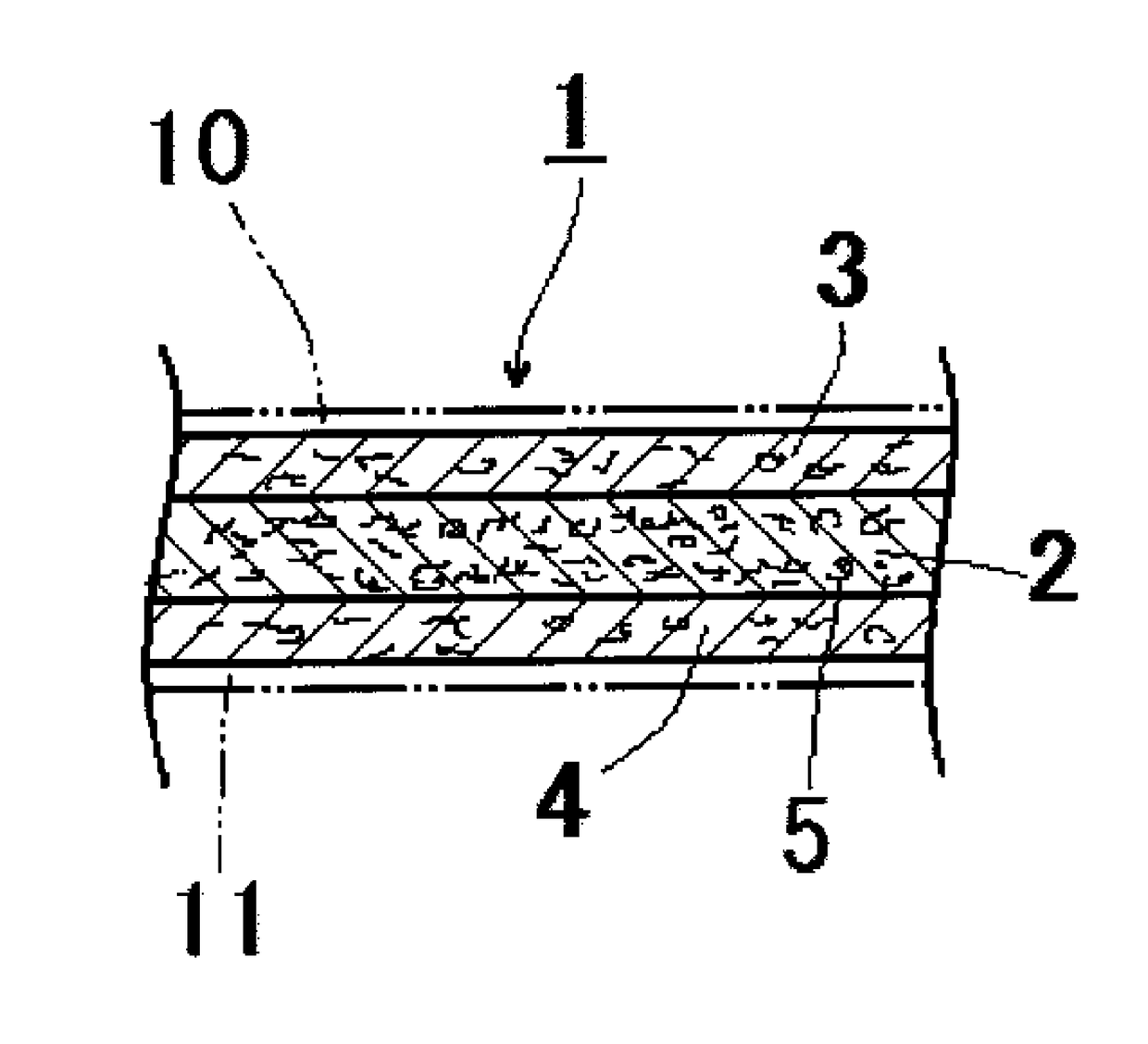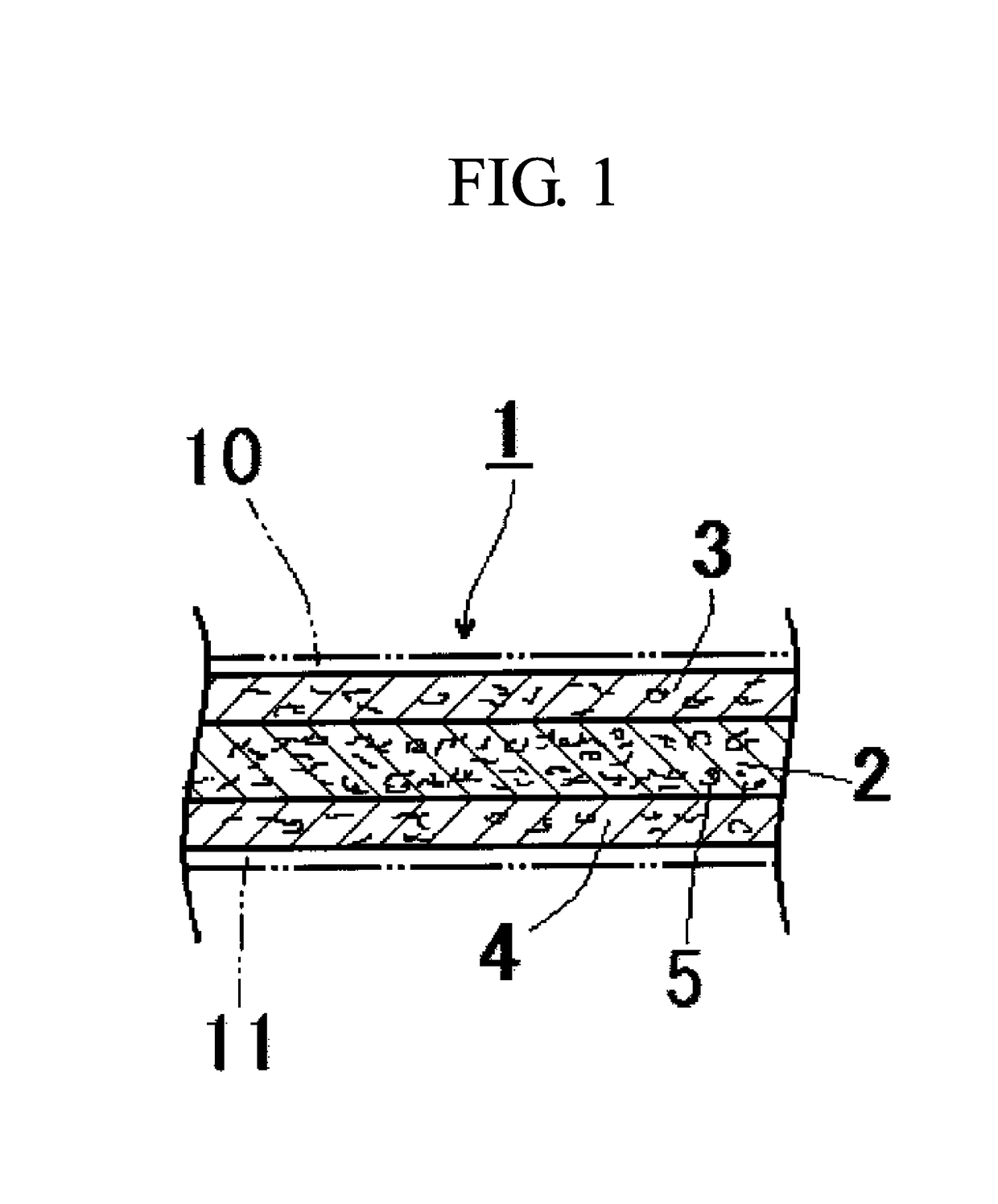Baseless double-sided adhesive sheet or tape, and method for manufacturing the same
a double-sided adhesive and base technology, applied in the field of double-sided adhesive sheets, can solve the problems of high cost of double-sided adhesive tapes employing bases, inability to reduce production effort, resource usage, etc., and achieve the effects of low flowability, relatively high fiber density of the adhesive layer (center layer) 2, and low cos
- Summary
- Abstract
- Description
- Claims
- Application Information
AI Technical Summary
Benefits of technology
Problems solved by technology
Method used
Image
Examples
example 1
er Film Forming by Ultraviolet Ray Curing Reaction
[0115]The adhesive layers 3 and 4 serving as the front face layer and the rear face layer were obtained by preparing an acrylic syrup composition by dissolving 10 wt % of added hydrogenated terpene phenol (manufactured by Yasuhara Chemical Co., Ltd., YS Polyster UH) as a tackifier in 100 wt % of an acrylic syrup (syrup manufactured by Soken Chemical & Engineering Co., Ltd.; trade name WS) as a primary polymerized prepolymer obtained by applying an aggregation polymerization method to a monomer such as acrylic acid 2-ethylhexyl, acrylic acid butyl, or acrylic acid.
[0116]0.7 wt % of PET short fibers having a fiber diameter of 5 denier and a fiber length of 5 mm were added and dispersed in 100 wt % of this acrylic syrup composition using an agitator.
[0117]Further, 0.5 wt % of an acetophenone-based photopolymerization initiator (manufactured by Ciba Specialty Chemicals; trade name IRGACURE 184) was added to 100 wt % of this acrylic syrup...
example 2
Layer Two Formation, Fiber Insertion into Layer Two
[0126]As illustrated in FIG. 2, Example 2 is a manufacturing method in which a structure is provided by: preparing a structure having the adhesive layer 3 in which the fibers 5 have been dispersed provided on a release paper 10 and an adhesive layer 12 in which the fibers 5 have been dispersed provided on the adhesive layer 3; preparing a structure having the adhesive layer 4 in which the fibers 5 have been dispersed provided on a release paper 11 and an adhesive layer 14 in which the fibers 5 have been dispersed provided on the adhesive layer 4; and providing the compatibilizing layer (adhesive layer) 2 by polymerizing the adhesive layer 14 with the adhesive layer 12.
[0127]The adhesive layers 3, 4, 12, and 14 employed a solvated acrylic composition (manufactured by Ipposha Oil Industries Co., Ltd., trade name 520), as a primary polymerized prepolymer obtained by applying a solution polymerization method to a monomer such as 2-ethyl...
example 3
Layer Two Formation, Fiber Insertion into Layer One
[0132]As illustrated in FIG. 3, Example 3 is a manufacturing method in which a structure is provided by: preparing a structure having the adhesive layer 3 provided on the release paper 10 and the adhesive layer 12 in which the fibers 5 had been dispersed provided on the adhesive layer 3; preparing a structure having the adhesive layer 4 provided on the release paper 11 and the adhesive layer 14 in which the fibers 5 had been dispersed provided on the adhesive layer 4; and providing a compatibilizing layer (adhesive layer) 2 by polymerizing the adhesive layer 14 with the adhesive layer 12.
[0133]The adhesive layers 3, 4, 12, and 14 employed a solvated acrylic composition (manufactured by Ipposha Oil Industries Co., Ltd.; trade name 520), as a primary polymerized prepolymer obtained by applying a solvent polymerization method to a monomer such as 2-ethylhexyl acrylate, butyl acrylate, or acrylic acid.
[0134]For the adhesive layers 3 and...
PUM
| Property | Measurement | Unit |
|---|---|---|
| length | aaaaa | aaaaa |
| total thickness | aaaaa | aaaaa |
| thickness | aaaaa | aaaaa |
Abstract
Description
Claims
Application Information
 Login to View More
Login to View More - R&D
- Intellectual Property
- Life Sciences
- Materials
- Tech Scout
- Unparalleled Data Quality
- Higher Quality Content
- 60% Fewer Hallucinations
Browse by: Latest US Patents, China's latest patents, Technical Efficacy Thesaurus, Application Domain, Technology Topic, Popular Technical Reports.
© 2025 PatSnap. All rights reserved.Legal|Privacy policy|Modern Slavery Act Transparency Statement|Sitemap|About US| Contact US: help@patsnap.com



